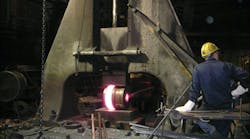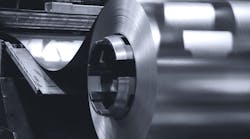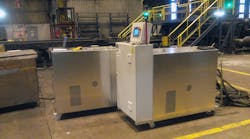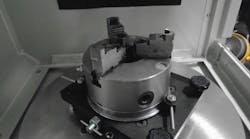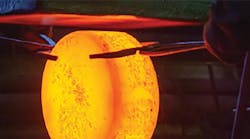Knowing more about why dies fail usually helps point the way for improvements in tool life especially if we learn from not only our own experiences, but also the experiences of others.
Dies fail for various reasons, including:
- Abrasive wear to out-of-tolerance conditions;
- Heat checking and spalling/accelerated wear out;
- Thermal softening and subsequent deformation of dies;
- Excessive “benching” (hand grinding/polishing);
- Catastrophic failure (broken dies); and,
- Inaccurate dies that miss target dimensions.
In most cases, dies that fail from “wear-out” have made a large number of parts and the dies can be resunk, or weld repaired and resunk, to obtain further life from the basic die block. These are not catastrophic failures, but failures nonetheless.
It’s unpredictable fractures and accelerated wear-outs that cause forge shops to fall off schedule, exceed die costs, increase part scrap and rework.
All dies that don’t experience breakage eventually wear out from abrasive wear. If they all failed this way, tool life could be much more predictable and manageable. Thus, the cost of this accelerated wear-out is more than just the tooling replacement costs because the corresponding forgings are often not to print and have to be scrapped due to the worn die condition. An unhappy customer is the most undesirable outcome.
The most dramatic tool failure is catastrophic die-block fracture. This stops everything until the die is replaced. Some sources indicate this is the reason for 10 to 23% of the die failures, depending on what’s defined as die fracturing and its source.
Catastrophic die fracture is often traced to poor fit-up in the forging equipment, poor die design, or incorrect die-block size selection, with some traceable to excessively hard dies or defective tool materials.
A major cause of die breakage is lack of sufficient die support, either at the sidewalls or due to improper match up with the supporting tools, such as bolsters, rams, die shoes, etc. Usually, die fracturing comes from a failure to adhere to fundamentals in tool support and die maintenance, as well as workpiece placement on the dies. Lack of proper preheating makes any fracture develop much faster — sometimes after just a few forgings.
Data has shown that defective die-block materials (e.g. pipe, segregation, wrong composition) are infrequent causes of die fractures. Thus, finger-pointing to the die-block source can lead to incomplete failure analyses, and then incomplete corrective actions.
According to data reported by Heinemeyer, who studied the failure rates for dies among German forgers, 20-25% of dies fail by cracking before they wear out. And yet, most die fractures are preventable with the application of some fundamental tool “fit up” and die support. There are useful guidelines on the subject of hammer dies and the importance of good shank and lock design to minimize losses from die fracture.
Two of the most frequent sources of accelerated wear-out failures are die checking and the tool erosion that comes from tool softening. When viewing a worn-out die, it is often difficult to determine the base cause since both of these conditions are frequently present as the die washes out. Data developed during this author’s experiences indicate that the distribution of failures shown in Table 1 is typical for hammer forging dies. The tool designer has the greatest influence on the items identified with design.
The proper fit between the die and the sow block is a well known, but sometimes overlooked, ingredient in preventing die fracture. If supreme care is not taken to ensure a flat, fully engaged, and tightly held surface between these vital machine and tool features, then die fracturing can literally be expected. This applies to the ram surfaces, too.
Frequently, poor support will result when different size die blocks are used. The smaller dies will often “Brinell” into the sow block, bolster, and/or rams. Indentations of up to 0.030 in. are not uncommon. If the blocks or rams are not trued up to remove these indentures, subsequently installed larger dies will tend to rest only on the four remaining corners, causing them to “flex” in the center. This situation has been the source of many hammer die failures.
Press dies are prone to this problem too when they are not properly supported over the entire surface of the die bottoms. For example, it is common for some press builders to install a die support system that includes an H-plate pattern to allow multiple ejector pins to be activated. The larger this H-plate pattern, the larger is the area of the dies that are unsupported. This has been found to be the source of die fractures in presses — especially if this H-plate pattern is enlarged to permit an ever-increasing ejector pin pattern.
Die fit-up and the importance of avoiding any flexing between these die features are vital ingredients in prevention of die fractures.
Die wear-out
It seems logical to focus on the sources of wear-out given a die that is sunk to “target” dimensions that are intentionally aimed at minimum (or maximum) part dimensions — where tool wear will eventually take the tool to maximum (or minimum) dimensions after continued use. By contrast, a die sunk to “nominal” dimensions will usually be “partially worn out” at the beginning of the set up.
In other words, a die sunk to exactly mid-point on the print tolerances will have about 40 to 60% less die life than one that is sunk to the ideal dimensions of about the low 20% of the print tolerances where wear moves each particular dimension. The goal here is to estimate which dimensions must be altered either down or up to account for the expected wear, and by how much, and still make good forgings at start up.
These pre-planned adjustments are important aspects of the successful precision forging of gears and other very tight tolerance parts. They should also apply to any forging. In other words, a die sunk to exactly mid-point on the print tolerances will have about 40 to 60% less die life than one sunk to the ideal dimensions of about the low 20% of the print tolerances.
Causes of die wear-out
There are a variety of causes of die wear-out. Dies are too soft at the outset of production. The die deforms in central regions. The die material may not have responded to heat treatment through the large section size, causing soft centers in the dies. Higher alloy die steel may be called for.
Die softening from heat up. In this case, the die actually deforms. The die material exceeds the softening temperature due to excessive contact times with hot parts, combined with insufficient cooling between forgings. Use water to cool off the dies, being careful about heat checking from the resultant thermal cycling. Die steels with more Cr and W will help develop greater heat resistance, but they also will show a greater tendency to crack under water cooling conditions that aren’t controlled properly. Welding selected portions of a die with cobalt-based alloys (e.g. Stellite) will also improve resistance to softening.
Die erosion caused by abrasion of oxides/scale. Again, die hardness can have a pronounced effect — harder dies wear more slowly — but can crack more quickly. Lubrication may reduce wear out from this reason. Consider using inserts. Attention should be paid to a powder-like scale formed on heating. Induction heating is favored for this.
Dies deform. Even hard dies. This is often caused by excessive pressure/or extra un-needed forging blows — possibly by cold material or by designing flash too thin for the configuration. Essentially the die fills up before the part is reduced to size, causing unnecessarily high stresses on the dies. It is important to adopt design modifications for reducing cavity pressure to extend die life.
Thermal fatigue, die checking. This can result in both spalling and galling on projections, and it is especially common when hardfacing is welded on, or when electro-deposited coatings are used on the die surfaces.
Bench wear-out
This is mostly due to excessive polishing of dies, due to galling or pressure welding of forged material to the die surfaces. This is noticeable especially in forging aluminum alloys and nickel-based alloys, which do not form a protective oxide to act as a “parting” compound. This is also a problem when forging steels heated in protective atmospheres.
An important aspect of die wear-out is surface wear, and the beneficial effects of wear-resistant coatings that can be applied to extend tool life should be considered. A good example is the use of nitriding to locally hardening the die surfaces.
Ion-nitriding to depths of 0.005 to 0.020 in. is beneficial for many dies used in hot forging. Such approaches are not as useful where these hard coatings actually lead to premature die checking (heat checking). Care must be taken to ensure the substrate is at least 44 Rc. Otherwise the harder layer will tend to deform and spall off, losing some or all of what might be gained with the harder layer.
Die fracture, breakage
Inadequate support of die/insert in holder. Frequently caused by out-of-flat conditions or loose shims, this is the reason for nearly half of all die fractures. There are times when H-section plates are used to extend ejectors over a large range of areas beneath the dies. This approach can lead to a lack of die support and expose dies to bending and eventual fracture.
Sections of die too thin to support loading during forging. Failures often originate through dowel notches or in fillet radii at shanks under impression — which are the most common locations for complete fracture. Check the die size versus the depth of the pockets.
Forging on cold dies where they are brittle. Typically, small cracks in the impression open up to form larger ones, or originate at the base of pockets in dies (typically for forming ribs on forgings.) Except in rare cases, forging in dies at temperatures below 200°F risk brittle fracture in most die steels.
Excessive blows after the dies fill. This tends to overload the die impression and can cause serious, and catastrophic, fracture. This is a common occurrence when forging in dies with relatively deep die cavities at the edges of the forgings, where the lateral loads on dies are highest. Use of supporting tooling should be considered.
Trapped lubricants in un-vented press dies. This is a frequent problem in forging dies containing impressions of varying depth. Crankshafts are a good example of this, as are wheel spindles. What happens is that the lubricant vapor or steam pressure has no escape in presses and when the cavity begins to fill, the gas compresses and begins to encroach into any small cracks in the die. This is a poorer practice than for hammer forgings, where deformation in more progressive and where the trapped steam is more of helpful in removing forging from the dies. This is why blind vents are usually adequate for hammer dies.
Lack of circumferential support on deep round dies. This is where there is a tendency to split a deeply pocketed die with a punch while back-extruding a conical or cylindrical part. External die support such as shrink bands are called for.
An example of a problem is the centrally located transverse fracture of long slender dies in presses and hammers — usually the failure is traceable to a lack of support — but then, maintaining tool holders perfectly flat for every set up is not always practicable. The alternative of using insert holders with “pre-cracked” multiple-section dies can often be the best approach this problem.
For example, instead of sinking a 12-ft long die block with the attendant risk of breakage, it can be more practical to build a somewhat longer sub-die holder and then either wedge fit, shrink fit, or press fit two or more die inserts into the sub-die holder. This total assembly then becomes the die block, which is fitted to the sow block or master tool holder in the press in the conventional way.
The selection of the parting planes between the inserts is based on where the die would have been most likely to have cracked during forging in a one-piece die. This can result in some minor die finning if the joining die inserts are not fitted properly. But, the likelihood of catastrophic failures is almost totally eliminated.
This inserting technique can also be used in hammers but attention to the locking features is critical to avoid disassembly, or breakage on impact.
For safety reasons, using separate clamps or bolting to hold inserts is not recommended for hammer dies. Using inserts with reverse tapers is essential for avoiding accidental disassembly.
